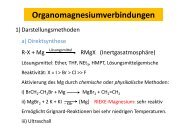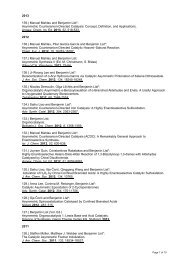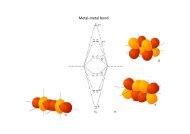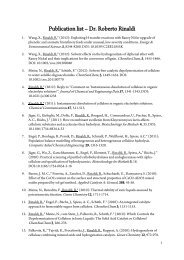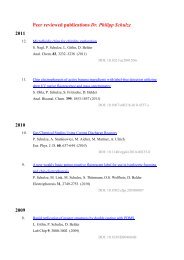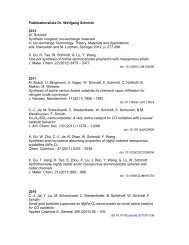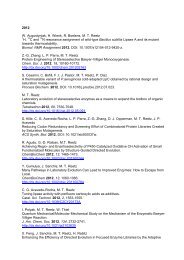5 - Max-Planck-Institut für Kohlenforschung
5 - Max-Planck-Institut für Kohlenforschung
5 - Max-Planck-Institut für Kohlenforschung
You also want an ePaper? Increase the reach of your titles
YUMPU automatically turns print PDFs into web optimized ePapers that Google loves.
History<br />
1.1 History of the <strong>Max</strong>-<strong>Planck</strong>-<strong>Institut</strong> <strong>für</strong> <strong>Kohlenforschung</strong><br />
The Kaiser-Wilhelm-<strong>Institut</strong> <strong>für</strong> <strong>Kohlenforschung</strong> (coal research) in Mülheim/Ruhr was<br />
founded in 1912 by the Kaiser Wilhelm Society, representatives of the coal industry and<br />
the town of Mülheim/Ruhr. In 1913 Franz Fischer (1877-1947), who in 1911 had been<br />
appointed professor for electrochemistry at the Technical University in Berlin-<br />
Charlottenburg, was chosen to be the first Director of the <strong>Institut</strong> <strong>für</strong> <strong>Kohlenforschung</strong>.<br />
Franz Fischer and his co-workers carried out basic research in a number of areas<br />
concerning the formation and chemical composition of coal as well as on its conversion<br />
into solid, liquid and gaseous products. The most important contribution culminated in<br />
the so-called Fischer-Tropsch process for coal liquefaction. In 1925, Franz Fischer and<br />
the group leader Hans Tropsch reported that liquid hydrocarbons (alkanes) can be<br />
produced from carbon monoxide and hydrogen in the presence of solid metal catalysts.<br />
The mixture of the two gases (synthesis gas) necessary for this new process was<br />
prepared by the "gasification" of coal with steam and oxygen at 900 °C. In 1925 the<br />
"Studien- und Verwertungsgesellschaft mbH" was founded for the purpose of exploiting<br />
the patents. By the early 1940s nine industrial plants were operating in Germany<br />
producing ca. 600 000 tons of liquid hydrocarbons per year. Today there is a renewed<br />
interest in Fischer-Tropsch technology with plants in Sasolburg/South Africa and in<br />
Malaysia. In 1939 Franz Fischer instigated a change in the status of the <strong>Institut</strong>e and it<br />
became a foundation of private law with the objective of supporting the scientific<br />
investigation of coal for the public benefit.<br />
Following Fischer's retirement in 1943 Karl Ziegler (1898-1973) was appointed<br />
Director of the <strong>Institut</strong>e. After the founding of the <strong>Max</strong> <strong>Planck</strong> Society as the successor<br />
of the Kaiser Wilhelm Society in 1948, the <strong>Institut</strong>e obtained its present name in 1949.<br />
As a consequence of Ziegler's appointment, the main research efforts in the <strong>Institut</strong>e<br />
shifted to organometallic chemistry. Based upon his earlier experience with the organic<br />
compounds of the alkali metals, Ziegler and his co-workers turned their attention to<br />
aluminum. In 1949 they reported the multiple addition of aluminum alkyls to ethylene<br />
which became known as the "Aufbau" reaction. The product of this oligomerization was<br />
a mixture of aluminum alkyls having long, linear alkyl chains attached to the metal and<br />
which could be converted into the corresponding α-olefins or primary alcohols, the<br />
latter being biodegradable detergents. An unexpected observation during the systematic<br />
investigation of this reaction led to the discovery that transition metals have a dramatic<br />
effect on the "Aufbau" reaction and, in particular, the addition of compounds of<br />
11



